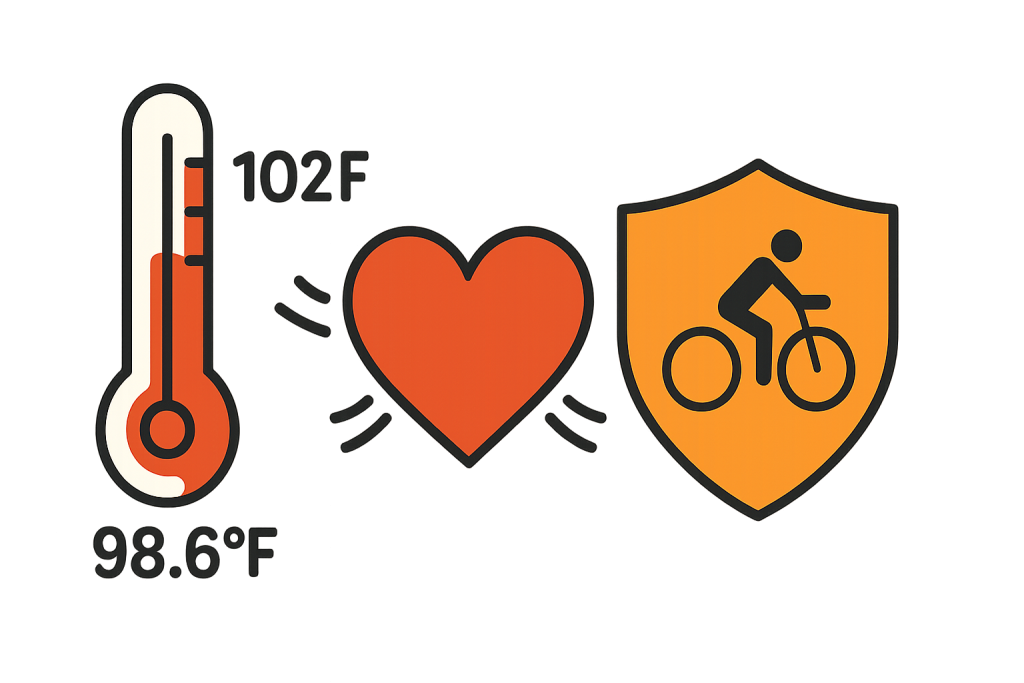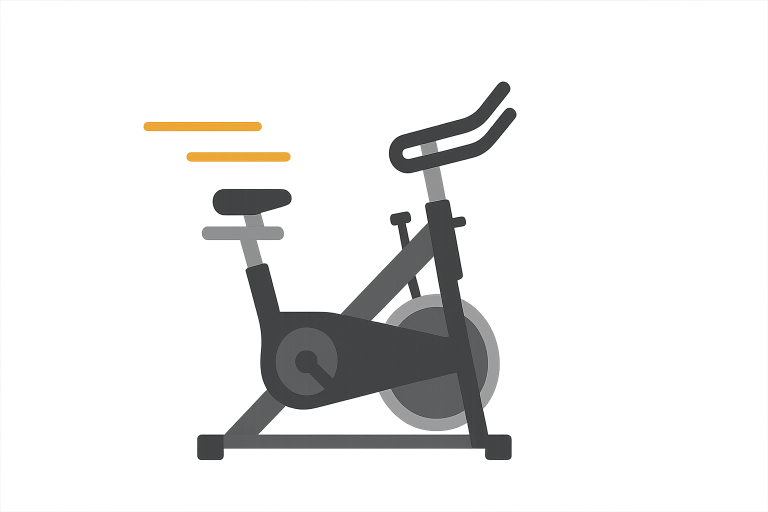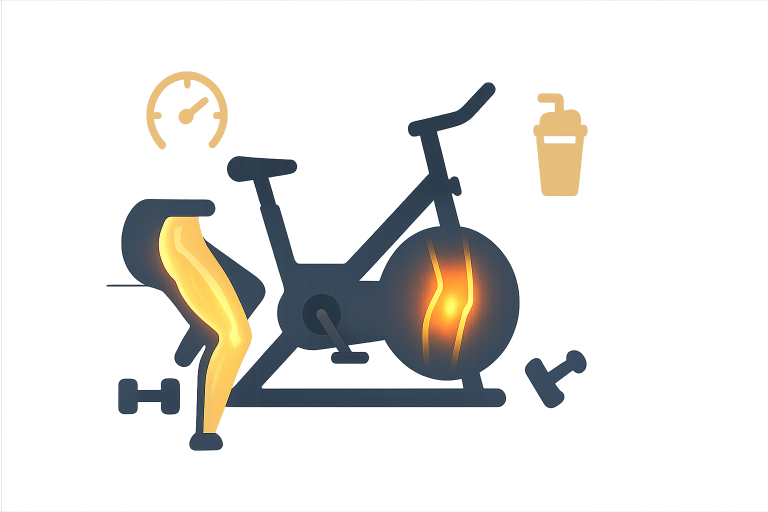How to Master Your Indoor Cycling Workout with a Proper Warm-Up
Warm-up exercises for indoor cycling are a critical component of the success of an indoor cyclist. I’ve spent the last seven years as an ISSA-certified nutritionist and fitness trainer, and in that time, I’ve seen countless cyclists make the same mistake. They jump on their exercise bike without warming up. The results are always the same: poor performance, sore muscles, and a higher risk of injury.
Early in my career, I learned this lesson the hard way. I skipped my warm-up before an intense indoor cycling session to save time. Fifteen minutes into the workout, I felt a sharp pull in my hamstring that put me on the sidelines for two weeks. That experience taught me a crucial lesson: warm-up exercises aren’t optional. They are the foundation of every great training session.
The Science Behind a Great Warm-Up
Your body isn’t a light switch that you can flip to full speed. It needs time to go from rest to peak performance, and this is where a warm-up comes into play. It’s a key part of preparing your body for a workout.
Why Your Body Needs to Warm Up
A proper warm-up does a few important things for your body:
- Increases Core Temperature: When you start dynamic exercises, your core temperature rises from its resting state of around 98.6°F to an ideal 101-102°F for exercise. This temperature rise is essential for muscle activation. Warm muscles contract more efficiently and with greater force than cold ones.
- Boosts Blood Circulation: Your cardiovascular system changes during a proper warm-up. Your blood vessels get wider, which allows more blood to reach your working muscles. This enhanced blood flow delivers oxygen and removes waste that can cause fatigue.
- Reduces Injury Risk: This is where a warm-up makes the biggest difference. A proper routine drastically reduces your risk of injury by preparing your muscles, tendons, and joints for the workout. Your hip flexors, hamstrings, and lower back are particularly at risk during indoor cycling. Cold muscles are like stiff rubber bands that can snap under stress. Dynamic stretching and activation work prepare these muscle groups for the repetitive motion of pedaling.

The Two-Part Warm-Up: Your Complete Guide
Through years of working with cyclists, I’ve developed a two-part warm-up system. It’s a comprehensive approach that gets you ready for your workout by focusing on both mobility and sport-specific preparation.
Part 1: The Off-Bike Warm-Up (5-10 Minutes)
Before you get on the bike, you need to prepare your entire body for movement. This off-bike phase is where you address tight spots and activate key muscle groups.
Dynamic Stretches for Major Muscle Groups

| Exercise | Description | Repetitions | Muscle Groups Targeted |
|---|---|---|---|
| Leg Swings (Forward/Backward) | Swing one leg forward and backward while holding a wall for balance. | 10 per leg | Hip flexors, hamstrings |
| Leg Swings (Side-to-Side) | Swing one leg across the body and out to the side. | 10 per leg | Hip flexors, adductors |
| Bodyweight Squats | Lower into a squat, keeping chest up and knees aligned with toes. | 2 sets of 10 | Quads, glutes, hamstrings |
| Ankle Circles | Rotate one ankle in circles while lifted off the ground. | 10 per direction, per ankle | Ankles, calves |
| Hip Circles | Rotate hips in large circles with hands on hips. | 10 per direction | Hip flexors, lower back |
| Torso Twists | Rotate torso left and right, keeping hips forward. | 10 per direction | Core, obliques |
| Arm Circles | Extend arms and make circles, increasing size gradually. | 10 forward, 10 backward | Shoulders, upper back |
Dynamic stretching is the best way to prepare your body for exercise. Unlike holding a stretch, these movements take your joints through their full range of motion while gradually increasing your muscle temperature.
Part 2: The On-Bike Warm-Up (5-10 Minutes)
Once you’ve prepared your body off the bike, it’s time for sport-specific work. This phase is the bridge between your general warm-up and your main workout.
Easy Spinning to Start
Get on your exercise bike and adjust your hand positions for comfort. This first part of the warm-up should feel almost effortless. Think of it as a gentle way to introduce your body to the cycling motion.
- Low Resistance, Low Cadence: Start with low resistance and a low cadence of 50-60 RPM. This combination increases blood flow to your legs without stressing your joints or heart. During this time, focus on your breathing and how your feet are moving. Your legs should feel light, and you should be able to hold a conversation easily.
- Gradual Intensity Increase: After 2-3 minutes of easy spinning, slowly increase both resistance and cadence. This gradual approach allows your body to get ready for the hard work ahead while your heart rate climbs steadily.
- Minutes 2-4: Increase your cadence to 70-80 RPM while keeping the resistance low.
- Minutes 4-6: Add a little resistance while keeping your cadence steady.
On-Bike Drills
Specific drills during your on-bike warm-up help you address common imbalances and prepare you for the demands of your main workout.

- Single-Leg Pedaling: This drill exposes strength differences between your right and left leg while improving how your muscles fire.
- Unclip your left foot and let it rest on the trainer or a small stool.
- Pedal with only your right leg for 30 seconds.
- Focus on smooth, circular pedal strokes.
- Switch legs and repeat with your left leg.
- Standing with Low Resistance: Practice getting out of the saddle with controlled, standing efforts.
- Increase resistance slightly from your seated position.
- Rise out of the saddle while keeping a steady cadence.
- Keep your upper body stable and avoid rocking from side to side.
- Hold for 15-20 seconds, then return to your seat.
The Specifics: A Detailed 10-Minute Warm-Up Routine
Here’s the exact 10-minute warm-up routine I use with my clients. It’s perfect for everything from a casual cardio workout to a serious time trial.
The Full Routine
| Time | Activity | Details | Purpose |
|---|---|---|---|
| 0-3 min | Off-Bike Dynamic Exercises | 2 sets of 10 squats, 10 leg swings per leg, 10 ankle circles per direction | Activate major muscle groups, increase mobility |
| 3-5 min | Transition to Bike | Adjust bike settings, settle into cycling position | Prepare body for cycling posture |
| 5-7 min | Easy Spinning | Low resistance, 50-60 RPM | Increase blood flow, warm up legs |
| 7-9 min | Gradual Intensity | 70-80 RPM, slight resistance increase | Build heart rate, prepare for effort |
| 9-10 min | Harder Effort | 80-90 RPM, 70% workout intensity | Bridge to main workout |
Why a Warm-Up Is So Important
After implementing this warm-up routine with hundreds of clients, the benefits are clear and measurable.
Key Benefits
- Better Performance: A proper warm-up leads to measurable improvements in power output and endurance. When your muscles are ready, you can access your maximum power earlier in your workout and maintain it longer. A 2011 study found a shorter, lower-intensity warm-up led to a 6.2% higher peak power output compared to a longer, traditional warm-up in sprint track cycling.
- Less Muscle Soreness: The mix of better blood circulation and gradual muscle activation significantly reduces post-workout soreness. Your muscles get more nutrients and can get rid of waste faster, which leads to a quicker recovery.
- Psychological Preparation: The mental benefits of a structured warm-up are just as important as the physical ones. This 10-minute period allows you to shift from your daily mindset into a training mindset. Use this time to review your workout goals and visualize your performance. This mental preparation often makes the difference between a good ride and a great ride.
A Final Word: Make It a Habit
From my experience training cyclists, I’ve learned that the difference between a good and a great performance often comes down to the small things we do consistently. A proper warm-up routine is one of those non-negotiable details.
The exercises in this guide are not just suggestions. They are essential parts of every successful training session. Whether you’re riding for 30 minutes or 90 minutes, this 10-minute investment will pay off in performance, injury prevention, and overall results.
Make this routine a part of your next indoor cycling workout. Your body will thank you with better performance, less soreness, and a reduced risk of injury. Most importantly, you’ll be building the foundation for long-term cycling success.
What warm-up exercises have you found most effective for your indoor cycling routine?






